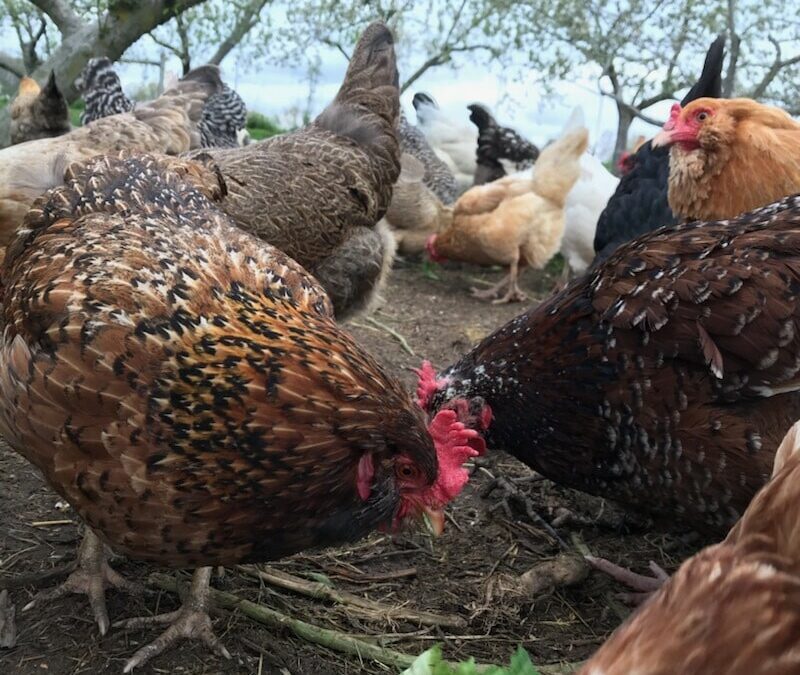
Want-to-Be Home Butchers Stuff Sausages at Stratford Ecological Center
March 3, 2012
Stratford Welcomes Sugar’s Twin Calves
May 5, 2012Published in The Delaware Gazette April 7 , 2012
Spring has come at least a month early to Stratford Ecological Center on Liberty Road. The spotted salamanders interrupted the traffic at a square dance on March 2, when they chose to make their annual night pilgrimage to the swamp. Farmer Jeff Dickinson spent longer assisting salamanders crossing the lane, between cars, than he spent on the dance floor.
The peepers could be heard at the swamp on March 7, coinciding with the final week of maple sugaring as the sap turned bitter. The sap to sugar ratio was much higher this year, due to the constant rains in 2011, and that meant a lot more cooking to obtain a total of seventeen gallons of flavorful maple syrup. A cabbage white butterfly was spotted by mid month and on St. Patrick’s Day the wild bloodroot and spring beauties were flowering in the Nature Preserve. By now many others have shown their faces, with the white trillium in full bloom, and a thick, tall green carpet predicting a wonderful show from our star performer, the wild blue hyacinths.
The apple, pear, and particularly the peach trees survived the drop in temperature during the night of March 26, thanks to an unusual phenomenon. The wind dried the air but also prevented our covering the trees to protect the blossoms. The temperature dropped to 25 F, with a lower dew point, and because the air was so dry the buds did not succumb to the freezing temperatures and the trees will bear fruit.
The greenhouse, with its eyeful of greens begging for u-pick, has reached its pinnacle for the winter. Large bagfuls are picked once a week and delivered to PIN, yet it is still hard to keep up before the plants are past their best. At that stage the hens and the compost pile benefit and, in turn the soil, then the new plants and then ourselves. The consistency of the web of life is indeed a source of nourishment for our bodies and our well being.
The farm and nature tours started up again three mornings a week, involving mostly K through 2nd graders. Their tours provide us with the best spring tonic as they hunt for 4-leaf clovers or stalk a lamb. The children made early plantings of kale and cabbage, and sprinkled carrot seeds in rows across the raised beds in the Children’s Garden. They tenderly watered the plants with tiny watering cans and figured everything would be fine.
Little did they know that the young brightly-colored Araucana hens would fly over the fence. They pulled up and ate every plant and scratched around, ensuring carrots will be surprising us in odd places this summer. Next week’s students will re-plant from the rich supply in the small greenhouse, and few will ever notice the difference.
Araucanas are renowned for both their little beards on either side of their face, and the fact they are “flighty.” They can fly higher than most breeds due to their body type. Farmer Jeff has now clipped their primary feathers, so when they do take off they fly in a curve and have to land. The feathers will grow back, but by then the habit will be broken. We moved them in with the orchard hens, making a total of 100 laying hens and three “guard” roosters.
The hens have been laying more eggs between them per day than I ever remember, and the eggs were a sight to be seen stacked high on the counter after washing. I wish more children could visit a farm and see where and how a real egg is laid. Too many kids, this time of year, think only of eating chocolate eggs, without any thought to the new life and food the eggs signify.
The animals have been grazing for six weeks in fact they were only in the barn for six weeks this winter, a record. We have a surplus of poorer hay, which we plan to use for mulch on our vegetable beds or for composting.
The west end of the north pasture which was planted in corn and turnips last year, has been chisel plowed and will go into oats for hay. Field 6, presently in rye grass, is still a little wet but as soon as possible we need to cultivate and plant spelt. Field 2 is thick with more clover than grass to make hay. Field 4 has an excellent growth of wide leaf alfalfa thanks to the spring moisture, and we plan to take it out of rotation and keep it for hay.
There are plenty of activities happening this month at Stratford including a new Small Farmers: Preschool Series and a new Farming with the Seasons: Farm Tours for Adults. As well as Vegetable Variety Seeding, Family Farm Chores, Story Time, and a Wild Flower Walk for adults. The ewes have finished lambing and produced 20 lambs. Few of the nanny goats look likely to kid soon and we are expecting a spread-out birthing season. We invite you to join us and enjoy springtime on the farm.
“Farm Connection” is a monthly article connecting city folk to life on the Stratford Ecological Center farm. It is published on the first Saturday of the month on the farm and garden page of The Delaware Gazette.





